The mycosis of the arrest is a disease with a high content of specific mushrooms, which is characterized by damage to the skin and nail plates.
The pathology is considered quite common and requires correct and, above all, timely treatment, since without passing the therapeutic course, the infected person threatensDiffusion of infection in large skin areas.
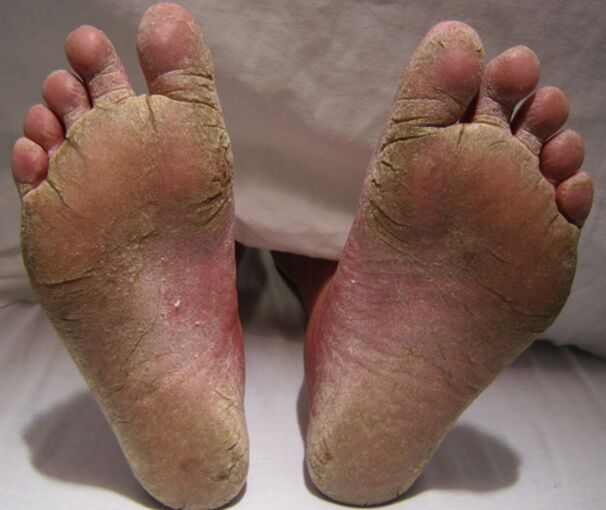
To avoid the appearance of complications, it is important to know how the disease appears and what symptomatic manifestations is accompanied by.
What does the virus look like on the leg sole?
After the penetration of the fungal infection in the body, under the influence of the conditions favorable to the vital activity of the conditions,In the places of their location, the inflammatory process begins.
Gradually, an infected person has characteristic symptoms that depend on the type of dermatomicosis.These include:
- A squamous shape, characterized by redness and peeling of the skin, as well as by the appearance of the cracks.There is no discomfort, which contributes to the spread of the disease.
- Dyshidrotic shape, which focuses on a series of feet that does not touch the surface of the floor.In the outbreaks of the lesion, small blisters are observed with transparent content located both in the internal and external part of the foot.Dip and erosion appear on the surface of the skin, itching and burning are felt.
- Intrigine form that mainly affects interdaltse intervals.The disease manifests itself in the form of exfoliating epidermis and cracks with a white edge along the edges.The pathology is poorly treated and has a long chronic course.
- The canceled shape is characterized by the appearance of the peeling of the skin and with a slight itching between the fingers.The shape is considered one of the simplest, therefore the disease can transmit alone even in the absence of adequate treatment.
How does mycosis manifest on fingers and feet?
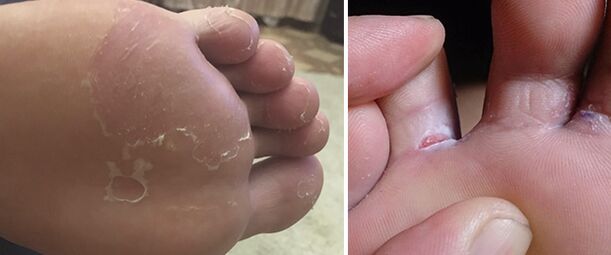
The fungal damage to the fingers and the feet is often combined with onychomicosis, a fungal damage to the nail plates.The disease has a series of clinical manifestationswith which it is easy to establish the development of the pathology.These include:
- Crepes and ulcers between the fingers of the feet;
- Exfolched areas of the skin;
- the appearance of white or yellow scales;
- the emergence of crying areas;
- Burn and itching;
- Inspiration and change of the color of the nail plates;
- fragility and exfoliation for nails;
- Painful sensations around the nail plates.
Important!Very often, the skin becomes red, the traces of combing appear on it.Perhaps the appearance of the dead skin between the fingers.
Symptoms and signs
The clinical picture of the mycosis of the stop depends directly on the shape and phase of a fungal disease.In some cases, pathology manifestations can be expressed or, on the contrary, deleted.It is important to identify symptoms in a timely manner to not complicate the process of eliminating them.
All symptoms of the mushroom can be divided in general and specific, characteristic of a certain form of the disease.
Peeling
The mushroom feeds on protein compounds and in the process of his life practicallycompletely destroys the protective layer of the skin.Consequently, the skin begins to detach strongly, many whitish stairs appear, which easily explode from the skin.
Itching
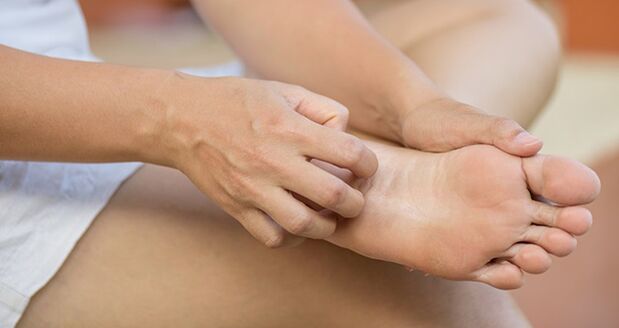
Due to the violation of the integrity and destruction of the skin, the body tries to launch the regeneration process, which is the main cause of uncomfortable sensations.During this period, a patient may have a serious itching and burning in injuries.The occurrence, duration and intensity of the discomfort depend on the individual characteristics of the human body.
Unpleasant smell
The development of the pathological process leads to a violation of the sebaceous glands.For this reason, over time, the infect has increased the sweating and the appearance of a specific unpleasant smell.
It is necessary to note that there are a group of people more subject to the development of yeast mushrooms on the skin.The probability of infection with a mushroom increases people with circulatory disorders, can be vascular diseases, injuries, diabetes or obesity.
In elderly patients, the probability of collecting mushrooms is much higher, because in people after 50 years all the processes in the body are inhibited and immunity is significantly reduced.
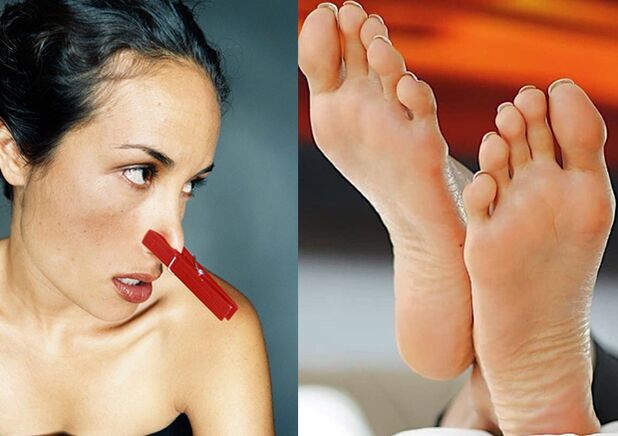
Changing the color of the skin
With the destruction of fibers containing keratin, the usual shade of the epidermis changes.The skin acquires a reddish, bluish or purple shade, covered with small points and cracks.
How to determine mycosis on the feet?
An infected person will be able to recognize the fungal injury of the feet in the initial phase of the development of the pathological process from the presence of the following symptoms:
- discomfort when walking;
- abundant skin peeling;
- compaction of the epidermis in the outbreaks of defeat;
- the appearance of an acute unpleasant smell;
- painful sensations during pressure;
- the formation of small cracks;
- itching and burning in areas affected by the mushroom;
- Change the color and structure of the nails.
If the pathology begins to move gradually in the advanced phase, the patient can observe:
- small red vesicles in the defeat area;
- swelling and redness of the epidermis;
- strong peeling and cracks in the interdigital gaps;
- Constant unbearable itching.
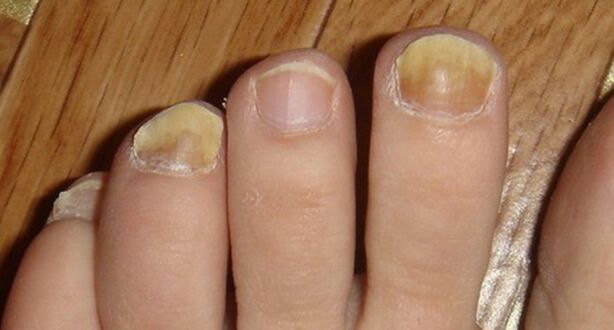
Important!When making the steam legs and hygienic procedures, the symptoms of the disease do not disappear, which is one of the main signs of infection.
Do I have to consult a doctor if the fungal diseases of the legs are detected?
Note the first symptomatic manifestations of Stop Mycosi,You should go immediately to the dermatologistFor further diagnostic measures.
The doctor will carry out a visual examination and provide a postponement for the tests, based on the results of which it will prescribe effective drugs with antifungal activities.
Important!The independent prescription of the medicines is unacceptable, since the incorrect choice of drugs can aggravate the situation and lead to the active development of the pathological process, following which the disease will enter an advanced phase.
The fungal lesion of the feet is a problem of which it is not easy to get rid of, but subject to the correctly selected treatmentThe recovery process will take only a few weeks.
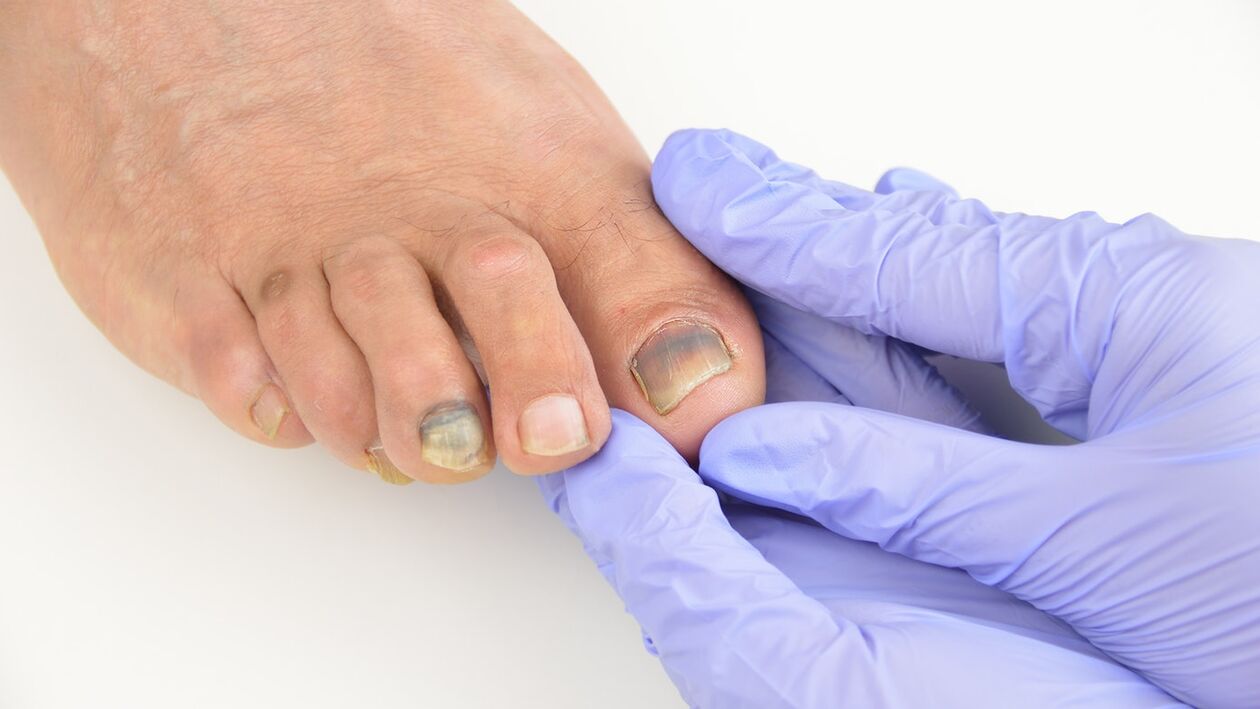
The fungal disease is accompanied by pronounced symptoms, which means that it will be recognized as a pathology in an initial development phase without allowing its progression.
















